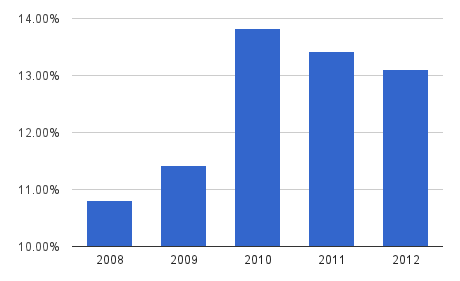Return on capital employed: the most revealing number in investing
Doing a few basic calculations can save you a lot of heartache when investing. And one calculation stands head and shoulders above the others: the ‘return on capital employed’, or Roce.
So you've found a company that you like the look of.
You think it has some good products, and that it will be able to sell more of them in the years ahead.
For some people, that's enough reason to go ahead and buy the shares.
MoneyWeek
Subscribe to MoneyWeek today and get your first six magazine issues absolutely FREE

Sign up to Money Morning
Don't miss the latest investment and personal finances news, market analysis, plus money-saving tips with our free twice-daily newsletter
Don't miss the latest investment and personal finances news, market analysis, plus money-saving tips with our free twice-daily newsletter
But rushing in like this is often a good way to lose money. By doing a few basic calculations you can save yourself a lot of heartache and sleep better at night.
And there's one calculation which I think stands head and shoulders above every other one.I've taken the 2012 annual report of supermarket group Morrisons to show you how to calculate it.
It's called: Return on capital employed (ROCE)
ROCE shows you what a company gets back (its profits) for the money that it invests (its capital employed).
Basically, this allows you to look at a company as if it was a savings account. When looking for a home for your savings, you usually put your money into the account that can pay you the best rate of interest.
Looking at companies in the same way is a good idea. Good companies make higher returns with the money they invest than bad ones. In other words, they make better use of the resources available to them which is ultimately the whole point of capitalism.
Here we'll look at how to calculate Morrisons' ROCE. The numbers we'll need and refer to are in the table below.
| Operating profit (A) | 973 |
| Total Assets | 9859 |
| Cash | -243 |
| Non-interest bearing current liabilities (NIBCL) | -2188 |
| Capital Employed (B) | 7428 |
| Shareholders' Equity | 5397 |
| Net debt | 1472 |
| Provisions | 548 |
| Pension deficit | 11 |
| Capital Employed (B) | 7428 |
| ROCE (A/B) | 13.10% |
How to calculate the return on capital employed
Profits are easy enough to explain. It's the money earned from selling goods and services less the costs involved in making and selling them.
Capital employed is not so straightforward to calculate. However, it's relatively easy to explain with an example.
You can calculate capital employed (or money invested) from a company's balance sheet. It can be done from either the asset side or the financing side.
For example, let take a house that is bought for £200,000. It's bought with £100,000 of the buyer's savings (or equity) and a £100,000 mortgage from the bank.
So the asset (the house) is valued at £200,000, which is the same as the amount of equity and debt used to finance it. You can use either the asset value, or the amount of financing, to work out the money invested or capital employed.
Morrisons' capital employed is calculated in a similar way. You take its assets (supermarkets, fixtures and fittings and stock of goods) and take away any cash that it has.
You also take away what are known as non-interest bearing current liabilities (NIBCL). These are items such as suppliers' bills and taxes that have not been paid. They are deducted because effectively the supplier and the taxman are giving you a source of free finance.
Alternatively, you can do the calculation from the financing side of Morrisons' balance sheet. Here you take the shareholders' equity and add it to net debt (borrowings less cash).
You also add items such as provisions. These are liabilities that have reduced shareholders' funds which have not been paid yet and might not be for some time. Pension fund deficits do the same but are added to capital employed as they are real, debt-like liabilities.
Just like our example with the house, the calculations from the asset and financing side of Morrisons' balance sheet are the same. Its ROCE is a respectable 13.1% - a lot better than cash in the bank.
Why ROCEmatters
The media tends to just talk about profits. A lot of investors just look at them too. But you need to know how a company's profits came about. Have Morrisons' profits come from selling more products or has it just opened more stores?
Think about this for a minute. If I have £1,000 in a savings account that pays 5% interest, I receive £50 of income each year. If I double my savings to £2,000 the following year and the interest rate stays at 5%, my interest income doubles as well to £100.
But my overall return is still 5%.
Companies can do the same thing. They can grow their profits just by investing more. That's okay as long as the returns are good enough. But which company is the better investment, the one that has to spend money to grow profits, or the one that grows it profits on the same amount of money invested?
This is why it's a good idea to calculate ROCE for at least five years so that you can spot any trends.
Morrisons ROCE

As you can see, Morrisons' ROCE was on an improving trend from 2008-10 but has fallen for the last couple of years. When you see a trend like this you should try and find out what's causing it. Has the company made some big investments that will eventually pay off, or is it a sign of a business that is beginning to struggle?
How to get the most out of ROCE calculations
Just calculating the normal ROCE figure can be very revealing, but the ratio can be broken down further to tell you even more.
That's because ROCE is simply a company's operating margin (the percentage of its sales it turns into profit) multiplied by its capital turnover (the amount of sales it makes for each £1 of money invested) as shown below:
operating profit/sales x sales/capital employed = operating profit/capital employed
Let's go back to Morrisons to see what it can tell you.
| 2008 | 4.72% | 2.29 | 10.80% |
| 2009 | 4.62% | 2.47 | 11.42% |
| 2010 | 5.89% | 2.35 | 13.82% |
| 2011 | 5.49% | 2.45 | 13.42% |
| 2012 | 5.51% | 2.38 | 13.10% |
What we can see here is that Morrisons' ROCE has largely been driven by improving operating margins. It is currently making £2.38 of sales per £1 invested compared to £2.29 in 2008.
Capital turnover is a very useful ratio and isn't used that much. But it's a good way to spot businesses that might be getting into difficulty.
It is very useful for looking at retail businesses such as supermarkets or pub groups which tend to grow by spending money on new outlets. This is because profit margins can be held up for a while by cutting costs, but there's not much you can do to hide the fact that the extra money being invested isn't generating the same amount of sales.
If profit margins then fall, ROCE can fall sharply. A falling capital turnover ratio might be an early warning sign to sell the shares.
So next time you think you've found a good investment, get the accounts and get your calculator out. A few minutes doing the calculations I've shown you here will be time well spent.
Get the latest financial news, insights and expert analysis from our award-winning MoneyWeek team, to help you understand what really matters when it comes to your finances.
Phil spent 13 years as an investment analyst for both stockbroking and fund management companies.
After graduating with a MSc in International Banking, Economics & Finance from Liverpool Business School in 1996, Phil went to work for BWD Rensburg, a Liverpool based investment manager. In 2001, he joined ABN AMRO as a transport analyst. After a brief spell as a food retail analyst, he spent five years with ABN's very successful UK Smaller Companies team where he covered engineering, transport and support services stocks.
In 2007, Phil joined Halbis Capital Management as a European equities analyst. He began writing for MoneyWeek in 2010.
-
 ‘Why I have ditched my Help to Buy ISA for cash savings and the stock market’
‘Why I have ditched my Help to Buy ISA for cash savings and the stock market’Without the 25% bonus, my Help to Buy ISA is effectively redundant, says MoneyWeek writer Sam Walker.
-
 Is your inheritance tax allowance cut if you sell to downsize or sell your home to pay for care?
Is your inheritance tax allowance cut if you sell to downsize or sell your home to pay for care?Downsizing relief is a little-known benefit that could save your loved ones tens of thousands of pounds in inheritance tax after you’ve died.